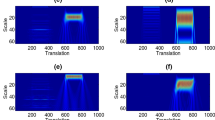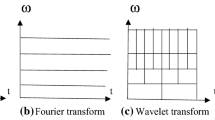Appendix A
Proof of Linearity Property:
$$ S\left\{{\alpha}_1{S}_1+{\alpha}_2{S}_2\right\}\left(t,\nu \right)={\alpha}_1S\left\{{S}_1\left(t,\nu \right)\right\}+{\alpha}_2S\left\{{S}_2\left(t,\nu \right)\right\} $$
(25)
$$ ={\int}_{-\infty}^{\infty }{\alpha}_1{S}_1(t)\frac{\mid \nu \mid }{\sqrt{2\pi }}\exp \left(\frac{-{\left(\tau -t\right)}^2{\nu}^2}{2}\right)\exp \left(-i2\pi \nu t\right) dt+{\int}_{-\infty}^{\infty }{\alpha}_2{S}_2(t)\frac{\mid \nu \mid }{\sqrt{2\pi }}\exp \left(\frac{-{\left(\tau -t\right)}^2{\nu}^2}{2}\right)\exp \left(-i2\pi \nu t\right) dt $$
(26)
$$ ={\alpha}_1{\int}_{-\infty}^{\infty }{s}_1(t)\frac{\mid \nu \mid }{\sqrt{2\pi }}\exp \left(\frac{-{\left(\tau -t\right)}^2{\nu}^2}{2}\right)\exp \left(-i2\pi \nu t\right) dt+{\alpha}_2{\int}_{-\infty}^{\infty }{s}_2(t)\frac{\mid \nu \mid }{\sqrt{2\pi }}\exp \left(\frac{-{\left(\tau -t\right)}^2{\nu}^2}{2}\right)\exp \left(-i2\pi \nu t\right) dt $$
(27)
$$ ={\alpha}_1S\left\{{S}_1\left(t,\nu \right)\right\}+{\alpha}_2S\left\{{S}_2\left(t,\nu \right)\right\} $$
(28)
In general, for n-dimension ST can be defined as
$$ S\left\{{\alpha}_1{S}_1+{\alpha}_2{S}_2+\dots +{\alpha}_n{S}_n\right\}\left(t,\nu \right)={\alpha}_1S\left\{{S}_1\left(t,\nu \right)\right\}+{\alpha}_2S\left\{{S}_2\left(t,\nu \right)\right\}+\dots +{\alpha}_nS\left\{{S}_n\left(t,\nu \right)\right\} $$
(29)
Appendix B
Proof of Shifting property:
$$ S\left\{{t}_1,{t}_2,{\nu}_1,{\nu}_2\right\}={\int}_{-\infty}^{\infty }{\int}_{-\infty}^{\infty }S\left({t}_1,{t}_2\right)\frac{\mid {\nu}_1\Big\Vert {\nu}_2\mid }{2\pi}\exp \left(\frac{-\left\{{\left({\tau}_1-{t}_1\right)}^2{\nu}_1^2+{\left({\tau}_2-{t}_2\right)}^2{\nu}_2^2\right\}}{2}\right)\exp \left(-j2\pi \left({t}_1{\nu}_1+{t}_2{\nu}_2\right)\right){dt}_1{dt}_2 $$
(30)
Suppose, S(t) function is shifted by ζ then,
$$ S\left\{{\tau}_1,{\tau}_2,{\nu}_1,{\nu}_2\right\}={\int}_{-\infty}^{\infty }{\int}_{-\infty}^{\infty }S\left({t}_1+{\zeta}_1,{t}_2+{\zeta}_2\right)\frac{\mid {\nu}_1\Big\Vert {\nu}_2\mid }{2\pi}\exp \left(\frac{-\left\{{\left({\tau}_1-{t}_1\right)}^2{\nu}_1^2+{\left({\tau}_2-{t}_2\right)}^2{\nu}_2^2\right\}}{2}\right)\exp \left(-j2\pi \left({t}_1{\nu}_1+{t}_2{\nu}_2\right)\right){dt}_1{dt}_2 $$
(31)
$$ ={\int}_{-\infty}^{\infty}\frac{\mid {\nu}_1\mid }{\sqrt{2\pi }}\exp \left(\frac{-{\left({\tau}_1-{t}_1\right)}^2{\nu}_1^2}{2}\right)\exp \left(-j2\pi {t}_1{\nu}_1\right){\int}_{-\infty}^{\infty }S\left({t}_1+{\zeta}_1,{t}_2+{\zeta}_2\right)\frac{\mid {\nu}_2\mid }{\sqrt{2\pi }}\exp \left(\frac{-{\left({\tau}_2-{t}_2\right)}^2{\nu}_2^2}{2}\right)\exp \left(-j2\pi {t}_2{\nu}_2\right){dt}_2{dt}_1 $$
(32)
Suppose, t2 + ζ2 = y and dt2 = dy then
$$ ={\int}_{-\infty}^{\infty}\frac{\mid {\nu}_1\mid }{\sqrt{2\pi }}\exp \left(\frac{-{\left({\tau}_1-{t}_1\right)}^2{\nu}_1^2}{2}\right)\exp \left(-j2\pi {t}_1{\nu}_1\right){\int}_{-\infty}^{\infty }S\left({t}_1+{\zeta}_1,y\right)\frac{\mid {\nu}_2\mid }{\sqrt{2\pi }}\exp \left(\frac{-{\left({\tau}_2-y+{\zeta}_2\right)}^2{\nu}_2^2}{2}\right)\exp \left(-j2\pi \left(y-{\zeta}_2\right){\nu}_2\right){dydt}_1 $$
(33)
Suppose, t1 + ζ1 = x and dt2 = dx then
$$ {\displaystyle \begin{array}{l}={\int}_{-\infty}^{\infty}\frac{\mid {\nu}_1\mid }{\sqrt{2\pi }}\exp \left(\frac{-{\left({\tau}_1-x+{\zeta}_1\right)}^2{\nu}_1^2}{2}\right)\exp \left(-j2\pi \left(x-{\zeta}_1\right){\nu}_1\right){\int}_{-\infty}^{\infty }S\left(x,y\right)\frac{\mid {\nu}_2\mid }{\sqrt{2\pi }}\exp \left(\frac{-{\left({\tau}_2-y+{\zeta}_2\right)}^2{\nu}_2^2}{2}\right)\\ {}\kern2em \exp \left(-j2\pi \left(y-{\zeta}_2\right){\nu}_2\right) dydx\end{array}} $$
(34)
$$ {\displaystyle \begin{array}{l}=\exp \left(j2\pi \left({\zeta}_1{\nu}_1+{\zeta}_2{\nu}_2\right)\right){\int}_{-\infty}^{\infty }{\int}_{-\infty}^{\infty }S\left(x,y\right)\frac{\mid {\nu}_1\mid }{\sqrt{2\pi }}\exp \left(\frac{-{\left({\tau}_1+{\zeta}_1-x\right)}^2{\nu}_1^2}{2}\right)\exp \left(-j2\pi x{\nu}_1\right)\frac{\mid {\nu}_2\mid }{\sqrt{2\pi }}\exp \left(\frac{-{\left({\tau}_2+{\zeta}_2-y\right)}^2{\nu}_2^2}{2}\right)\\ {}\kern2em \exp \left(-j2\pi y{\nu}_2\right) dydx\end{array}} $$
(35)
$$ {\displaystyle \begin{array}{l}=\exp \left(j2\pi \left({\zeta}_1{\nu}_1+{\zeta}_2{\nu}_2\right)\right){\int}_{-\infty}^{\infty }{\int}_{-\infty}^{\infty }S\left(x,y\right)\frac{\mid {\nu}_1\mid }{\sqrt{2\pi }}\frac{\mid {\nu}_2\mid }{\sqrt{2\pi }}\exp \left(\frac{-\left\{{\left({\tau}_1+{\zeta}_1-x\right)}^2{\nu}_1^2+{\left({\tau}_2+{\zeta}_2-y\right)}^2{\nu}_2^2\right\}}{2}\right)\\ {}\kern2em \exp \left(-j2\pi \left({\nu}_1x+{\nu}_2y\right)\right) dydx\end{array}} $$
(36)
$$ =\exp \left(j2\pi \left({\zeta}_1{\nu}_1+{\zeta}_2{\nu}_2\right)\right)S\left\{x,y,{\nu}_1,{\nu}_2\right\} $$
(37)
Similarly, for n-dimensional ST can be defined as
$$ S\left\{{t}_1\pm {\zeta}_1,{t}_2\pm {\zeta}_2,\dots, {t}_n\pm {\zeta}_n,{\nu}_1,{\nu}_2,\dots, {\nu}_n\right\}=\exp \left(\pm j2\pi \left({\zeta}_1{\nu}_1+{\zeta}_2{\nu}_2+\dots +{\zeta}_n{\nu}_n\right)\right)\mathcal{S}\left\{h\left({t}_1,{t}_2,\dots, {t}_n,{\nu}_1,{\nu}_2,\dots, {\nu}_n\right)\right\} $$
(38)
Appendix C
Proof of Scaling Property:
$$ S\left\{{t}_1,{t}_2,{\nu}_1,{\nu}_2\right\}={\int}_{-\infty}^{\infty }{\int}_{-\infty}^{\infty }S\left({t}_1,{t}_2\right)\frac{\mid {\nu}_1\Big\Vert {\nu}_2\mid }{2\pi}\exp \left(\frac{-\left\{{\left({\tau}_1-{t}_1\right)}^2{\nu}_1^2+{\left({\tau}_2-{t}_2\right)}^2{\nu}_2^2\right\}}{2}\right)\exp \left(-j2\pi \left({t}_1{\nu}_1+{t}_2{\nu}_2\right)\right){dt}_1{dt}_2 $$
(39)
$$ S\left\{{a}_1{t}_1,{a}_2{t}_2,{\nu}_1,{\nu}_2\right\}={\int}_{-\infty}^{\infty }{\int}_{-\infty}^{\infty }S\left({a}_1{t}_1,{a}_2{t}_2\right)\frac{\mid {\nu}_1\Big\Vert {\nu}_2\mid }{2\pi}\exp \left(\frac{-\left\{{\left({\tau}_1-{t}_1\right)}^2{\nu}_1^2+{\left({\tau}_2-{t}_2\right)}^2{\nu}_2^2\right\}}{2}\right)\exp \left(-j2\pi \left({t}_1{\nu}_1+{t}_2{\nu}_2\right)\right){dt}_1{dt}_2 $$
(40)
Suppose, a1t1 = pand a2t2 = q, hence \( {dt}_1=\frac{dp}{\mid {a}_1\mid } \) and \( {dt}_2=\frac{dq}{\mid {a}_2\mid } \), then
$$ =\frac{1}{\mid {a}_1\Big\Vert {a}_2\mid }{\int}_{-\infty}^{\infty }{\int}_{-\infty}^{\infty }S\left(p,q\right)\frac{\mid {\nu}_1\Big\Vert {\nu}_2\mid }{2\pi}\exp \left(\frac{-\left({\left({\tau}_1-\frac{p}{a_1}\right)}^2{\nu}_1^2+{\left({\tau}_2-\frac{q}{a_2}\right)}^2{\nu}_2^2\right)}{2}\right)\exp \left(-j2\pi \left(\frac{p{\nu}_1}{a_1}+\frac{q{\nu}_2}{a_2}\right)\right) dpdq $$
(41)
$$ =\frac{1}{\mid {a}_1\Big\Vert {a}_2\mid }{S}_h\left\{{a}_1{\tau}_1,{a}_2{\tau}_2,\frac{\nu_1}{a_1},\frac{\nu_2}{a_2}\right\} $$
(42)
$$ =\frac{1}{\mid \mathrm{detM}\mid }{S}_h\left\{\left({a}_1{\tau}_1,{a}_2{\tau}_2,{M}^{-T}\nu \right)\right\} $$
(43)
where, \( M=\left[\begin{array}{cc}{a}_1& 0\\ {}0& {a}_2\end{array}\right] \)and detM = a1a2 ≠ 0
$$ {M}^T=\left[\begin{array}{cc}{a}_1& 0\\ {}0& {a}_2\end{array}\right] $$
(44)
$$ \mathrm{Or},\kern0.5em {M}^{-T}=\left[\begin{array}{cc}\raisebox{1ex}{$1$}\!\left/ \!\raisebox{-1ex}{${a}_1$}\right.& 0\\ {}0& \raisebox{1ex}{$1$}\!\left/ \!\raisebox{-1ex}{${a}_2$}\right.\end{array}\right] $$
(45)
where T is the transpose of the matrix
$$ \mathcal{S}\left\{h\left({a}_1{\tau}_1,{a}_2{\tau}_2,{\nu}_1,{\nu}_2\right)\right\}=\frac{1}{\mid \mathrm{detM}\mid }{S}_h\left\{\left({a}_1{\tau}_1,{a}_2{\tau}_2,{M}^{-T}\nu \right)\right\} $$
(46)
Similarly, for n-dimensional ST can be defined as
$$ \mathcal{S}\left\{h\left({a}_1{t}_1,{a}_2{t}_2,\dots, {a}_n{t}_n,{\nu}_1,{\nu}_2,\dots, {\nu}_n\right)\right\}=\frac{1}{\mid {a}_1\mid, \mid {a}_2\mid, \dots, \mid {a}_n\mid }{S}_h\left\{\left({a}_1{\tau}_1,{a}_1{\tau}_2,\dots, {a}_1{\tau}_n,\frac{\nu_1}{a_1},\frac{\nu_2}{a_2},\dots, \frac{\nu_n}{a_n}\right)\right\} $$
(47)
Appendix D
Proof of Complex Conjugate Property:
$$ S\left\{h\left({t}_1,{t}_2\right)\right\}={\int}_{-\infty}^{\infty }{\int}_{-\infty}^{\infty}\left\{{\int}_{-\infty}^{\infty }{\int}_{-\infty}^{\infty }{S}_h\left({t}_1,{t}_2,{\nu}_1,{\nu}_2\right)d{t}_1d{t}_2\right\}\exp \left(j2\pi \left({t}_1{\nu}_1+{t}_2{\nu}_2\right)\right)d{\nu}_1d{\nu}_2 $$
(48)
Taking complex conjugate represented as ‘*’ in both sides, give
$$ {S}^{\ast}\left\{h\left({t}_1,{t}_2\right)\right\}={\int}_{-\infty}^{\infty }{\int}_{-\infty}^{\infty}\left\{{\int}_{-\infty}^{\infty }{\int}_{-\infty}^{\infty }{S}_h^{\ast}\left({t}_1,{t}_2,{\nu}_1,{\nu}_2\right)d{t}_1d{t}_2\right\}\exp \left(-j2\pi \left({t}_1{\nu}_1+{t}_2{\nu}_2\right)\right)d{\nu}_1d{\nu}_2 $$
(49)
Substituting ν1 = − ν1 and ν2 = − ν2 then
$$ ={\int}_{-\infty}^{\infty }{\int}_{-\infty}^{\infty}\left\{{\int}_{-\infty}^{\infty }{\int}_{-\infty}^{\infty }{S}_h^{\ast}\left({t}_1,{t}_2,-{\nu}_1,-{\nu}_2\right)d{t}_1d{t}_2\right\}\exp \left(j2\pi \left({t}_1{\nu}_1+{t}_2{\nu}_2\right)\right)d{\nu}_1d{\nu}_2 $$
(50)
$$ ={S}^{-1}\left\{{H}^{\ast}\left({t}_1,{t}_2,-{\nu}_1,-{\nu}_2\right)\right\} $$
(51)
In general, n-dimensional ST can be defined as
$$ {S}^{\ast}\left\{h\left({t}_1,{t}_2,\dots, {t}_n\right)\right\}={S}^{-1}\left\{{H}^{\ast}\left({t}_1,{t}_2,\dots, {t}_n,-{\nu}_1,-{\nu}_2,\dots, -{\nu}_n\right)\right\} $$
(52)
Similar to the 1-dimension case, it S(t)is even then S{S(t, ν)}is even and if S(t)is real and even then S{S(t, ν)}is real and even.
Appendix E
Proof of Time Reversal Property:
By using the definition of ST, the function h(−t1, −t2) can be expressed as
$$ S\left\{h\left(-{t}_1,-{t}_2\right)\right\}={\int}_{-\infty}^{\infty }{\int}_{-\infty}^{\infty }h\left(-{t}_1,-{t}_2\right)\frac{\mid {\nu}_1\Big\Vert {\nu}_2\mid }{2\pi}\exp \left(\frac{-\left\{{\left({\tau}_1+{t}_1\right)}^2{\nu}_1^2+{\left({\tau}_2+{t}_2\right)}^2{\nu}_2^2\right\}}{2}\right)\exp \left(-j2\pi \left({t}_1{\nu}_1+{t}_2{\nu}_2\right)\right)d{t}_1d{t}_2 $$
(53)
Substituting−t1 = u1 − t2 = u2, anddt1 = − du1, dt2 = − du2 in (53),
$$ ={\int}_{-\infty}^{\infty }{\int}_{-\infty}^{\infty }h\left({u}_1,{u}_2\right)\frac{\mid {\nu}_1\Big\Vert {\nu}_2\mid }{2\pi}\exp \left(\frac{-\left\{{\left({\tau}_1-{u}_1\right)}^2{\nu}_1^2+{\left({\tau}_2-{u}_2\right)}^2{\nu}_2^2\right\}}{2}\right)\exp \left(-j2\pi \left(-{u}_1{\nu}_1-{u}_2{\nu}_2\right)\right)d{u}_1d{u}_2 $$
(54)
$$ ={\int}_{-\infty}^{\infty }{\int}_{-\infty}^{\infty }h\left({u}_1,{u}_2\right)\frac{\mid {\nu}_1\Big\Vert {\nu}_2\mid }{2\pi}\exp \left(\frac{-\left\{{\left({\tau}_1-{u}_1\right)}^2{\nu}_1^2+{\left({\tau}_2-{u}_2\right)}^2{\nu}_2^2\right\}}{2}\right)\exp \left(j2\pi \left({u}_1{\nu}_1+{u}_2{\nu}_2\right)\right)d{u}_1d{u}_2 $$
(55)
Therefore,
$$ S\left\{h\left(-{t}_1,-{t}_2\right)\right\}\overset{ST}{\leftrightarrow }{S}_h^{\ast}\left(-{u}_1,-{u}_2,{\nu}_1,{\nu}_2\right) $$
(56)
Similarly, for n-dimensional, the ST can be defined as
$$ S\left\{h\left(-{t}_1,-{t}_2,\dots, {t}_n\right)\right\}\overset{ST}{\leftrightarrow }{S}_h^{\ast}\left(-{t}_1,-{t}_2,\dots, {t}_n,{\nu}_1,{\nu}_2,\dots, {\nu}_n\right) $$
(57)
Appendix F
Proof of Time-derivatives Property:
Considering the definition of n-dimensional IST of h(t)can be written as
$$ h\left(t,\nu \right)=\underset{\Re^n}{\int}\left(\underset{\Re^n}{\int }{S}_h\left(t,\nu \right) d t\right)\exp \left(j2\pi t\nu \right) d\nu $$
(58)
For n = 2, the IST of h(t)can be defined as
$$ h\left({t}_1,{t}_2,{\nu}_1,{\nu}_2\right)=\underset{\Re^2}{\int}\left(\underset{\Re^2}{\int }{S}_h\left({u}_1,{u}_2,{\nu}_1,{\nu}_2\right){du}_1{du}_2\right)\exp \left(j2\pi \left({t}_1,{t}_2,{\nu}_1,{\nu}_2\right)\right)d{\nu}_1d{\nu}_2 $$
(59)
Comparing (59) with the definition of FT, after that differentiating it with respect to time in both sides as
$$ \frac{d^2}{dt_1{dt}_2}\left\{h\left({t}_1,{t}_2,{\nu}_1,{\nu}_2\right)\right\}=\frac{d^2}{dt_1{dt}_2}\left\{\underset{\Re^2}{\int}\left(\underset{\Re^2}{\int }{S}_h\left({u}_1,{u}_2,{\nu}_1,{\nu}_2\right){du}_1{du}_2\right)\exp \left(j2\pi \left({t}_1,{t}_2,{\nu}_1,{\nu}_2\right)\right)d{\nu}_1d{\nu}_2\right\} $$
(60)
$$ =\underset{\Re^2}{\int}\left(\underset{\Re^2}{\int }{S}_h\left({u}_1,{u}_2,{\nu}_1,{\nu}_2\right){du}_1{du}_2\right)\frac{d^2}{dt_1{dt}_2}\exp \left(j2\pi \left({t}_1,{t}_2,{\nu}_1,{\nu}_2\right)\right)d{\nu}_1d{\nu}_2 $$
(61)
$$ =\underset{\Re^2}{\int}\left(\underset{\Re^2}{\int }{S}_h\left({u}_1,{u}_2,{\nu}_1,{\nu}_2\right){du}_1{du}_2\right)\left\{j2\pi \left({\nu}_1,{\nu}_2\right)\right\}\exp \left(j2\pi \left({t}_1,{t}_2,{\nu}_1,{\nu}_2\right)\right)d{\nu}_1d{\nu}_2 $$
(62)
$$ =j2\pi \left({\nu}_1,{\nu}_2\right){S}_h\left({u}_1,{u}_2,{\nu}_1,{\nu}_2\right) $$
(63)
Therefore,
$$ \frac{d^2}{dt_1{dt}_2}\left\{h\left({t}_1,{t}_2,{\nu}_1,{\nu}_2\right)\right\}\overset{ST}{\leftrightarrow }j2\pi \left({\nu}_1,{\nu}_2\right){S}_h\left({u}_1,{u}_2,{\nu}_1,{\nu}_2\right) $$
(64)
Similarly, for n-dimensional ST can be defined as
$$ \frac{d^n}{d{t}_1d{t}_2\dots d{t}_n}\left\{h\left({t}_1,{t}_2,\dots, {t}_n,{\nu}_1,{\nu}_2,\dots, {\nu}_n\right)\right\}\overset{ST}{\leftrightarrow }j2\pi \left({\nu}_1,{\nu}_2,\dots, {\nu}_n\right){S}_h\left({u}_1,{u}_2,\dots, {u}_n,{\nu}_1,{\nu}_2,\dots, {\nu}_n\right) $$
(65)
Appendix G
Proof of Parseval’s theorem:
Using the expression of inverse ST for two dimensional h(t) [2] as
$$ h\left({t}_1,{t}_2,{\nu}_1,{\nu}_2\right)=\underset{{\mathfrak{R}}^2}{\int}\left(\underset{{\mathfrak{R}}^2}{\int }{S}_h\left({u}_1,{u}_2,{\nu}_1,{\nu}_2\right)d{u}_1d{u}_2\right)\exp \left(j2\pi \left({t}_1,{t}_2,{\nu}_1,{\nu}_2\right)\right)d{\nu}_1d{\nu}_2 $$
(66)
Similarly, taking the complex conjugate of (66),
$$ {h}^{\ast}\left({t}_1,{t}_2,{\nu}_1,{\nu}_2\right)=\underset{{\mathfrak{R}}^2}{\int}\left(\underset{{\mathfrak{R}}^2}{\int }{S}_h^{\ast}\left({u}_1,{u}_2,{\nu}_1,{\nu}_2\right)d{u}_1d{u}_2\right)\exp \left(-j2\pi \left({t}_1,{t}_2,{\nu}_1,{\nu}_2\right)\right)d{\nu}_1d{\nu}_2 $$
(67)
Now, the LHS of Parseval’s theorem is written as
$$ {\displaystyle \begin{array}{c}\underset{{\mathfrak{R}}^2}{\int }h\left({t}_1,{t}_2,{\nu}_1,{\nu}_2\right){h}^{\ast}\left({t}_1,{t}_2,{\nu}_1,{\nu}_2\right)d{t}_1d{t}_2=\underset{{\mathfrak{R}}^2}{\int }h\left({t}_1,{t}_2,{\nu}_1,{\nu}_2\right)\underset{{\mathfrak{R}}^2}{\int}\left(\underset{{\mathfrak{R}}^2}{\int }{S}_h^{\ast}\left({u}_1,{u}_2,{\nu}_1,{\nu}_2\right)d{u}_1d{u}_2\right)\\ {}\kern3em \exp \left(-j2\pi \left({t}_1,{t}_2,{\nu}_1,{\nu}_2\right)\right)d{\nu}_1d{\nu}_2d{t}_1d{t}_2\end{array}} $$
(68)
Now, by the convergence property of ST into FT, once the ST is integrated foru1, u2 variable, that is
$$ {H}^{\ast}\left({\nu}_1,{\nu}_2\right)=\underset{{\mathfrak{R}}^2}{\int }{S}_h^{\ast}\left({u}_1,{u}_2,{\nu}_1,{\nu}_2\right)d{u}_1d{u}_2 $$
(69)
Substituting (69) into (68) and rearranging the terms
$$ =\underset{{\mathfrak{R}}^2}{\int }{H}^{\ast}\left({\nu}_1,{\nu}_2\right)\underset{{\mathfrak{R}}^2}{\int}\left\{h\left({t}_1,{t}_2,{\nu}_1,{\nu}_2\right)\exp \left(-j2\pi \left({t}_1,{t}_2,{\nu}_1,{\nu}_2\right)\right)d{t}_1d{t}_2\right\}\kern0.1em d{\nu}_1d{\nu}_2 $$
(70)
$$ =\underset{{\mathfrak{R}}^2}{\int }H\left({\nu}_1,{\nu}_2\right){H}^{\ast}\left({\nu}_1,{\nu}_2\right)d{\nu}_1d{\nu}_2 $$
(71)
Therefore, after transformation, the energy is preserved. Hence, it is written as
$$ \underset{{\mathfrak{R}}^2}{\int }{\left|h\left({t}_1,{t}_2\right)\right|}^2d{t}_1d{t}_2=\underset{{\mathfrak{R}}^2}{\int }{\left|H\Big({\nu}_1,{\nu}_2\Big)\right|}^2d{\nu}_1d{\nu}_2 $$
(72)
Similarly, for n-dimensional, the ST can be defined as
$$ \underset{{\mathfrak{R}}^n}{\int }{\left|h\left({t}_1,{t}_2,\dots, {t}_n\right)\right|}^2d{t}_1d{t}_2\dots d{t}_n=\underset{{\mathfrak{R}}^n}{\int }{\left|H\Big({\nu}_1,{\nu}_2,\dots, {\nu}_n\Big)\right|}^2d{\nu}_1d{\nu}_2\dots d{\nu}_n $$
(73)







